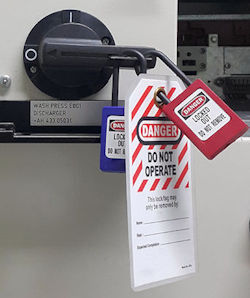Step 3. Secure Energy-Isolating Devices in a Safe Position
When equipment has been shut down, and then de-energized using an energy-isolating device, nothing will prevent the energy-isolating device from accidentally (or intentionally) being turned on, reopened, or reactivated until it is secured.

Locking Out
Locking out, also known as "lockout" (LO), is a procedure for physically securing energy-isolating devices in an off, closed, or neutral position. A lockout device - typically a lock with a unique key - secures the energy-isolating device in a safe position. When an energy-isolating device is secured by a lockout device, it physically prevents the energy-isolating device from being manipulated.
Tagging Out
Tagging out, also known as "tagout: (TO), when performed correctly, is a procedure for securing a warning sign to an energy-isolating device when a lockout device cannot be used.
Key Criteria When Applying Lockout/Tagout Devices
- Authorized workers must attach lockout or tagout devices to each energy isolating device.
- Lockout devices, where used, must be attached in a manner that will hold the energy isolating devices in a "safe" or "off" position.
- Where tagout devices are used, it must be attached in a manner that will clearly indicate that the operation or movement of energy isolating devices from the "safe" or "off" position is prohibited.
- If the tag can not be attached directly to the energy isolating device, the tag must be located as close as safely possible to the device, in a position that will be immediately obvious to anyone attempting to operate the device.
- A tagout device must be securely fastened to the energy-isolating device and must state that the equipment being serviced can't be operated until it is removed.
Knowledge Check Choose the best answer for the question.
3-4. To physically prevent an energy-isolating device from being manipulated, it must be _____.
You forgot to answer the question!
